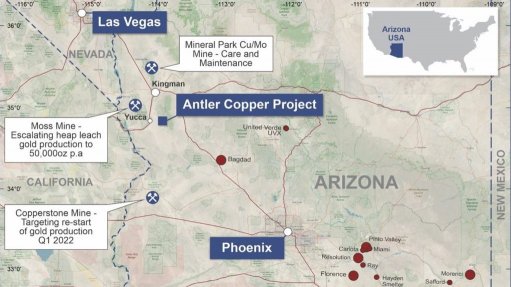Top trends impacting on mining come under the spotlight


ANDREW LANE The mining industry is realising that it operates in an ecosystem where it is dependent on governments for regulatory access and to communities for physical access
Photo by Duane Daws
At project delivery and engineering consultancy WorleyParsons’ Supplier Grow Conference earlier this month in Johannesburg, advisory firm Deloitte Africa energy and resource leader Andrew Lane discussed ten trends currently impacting on the global mining industry.
The first trend highlighted was creating shareholder value. Lane pointed out that mining companies had to deliver a return on shareholders’ investments and had historically received investments on the assumption that the future would bring positive returns. However, he asserted that, in the last five years, shareholders had started demanding dividends before providing more capital.
Shareholder value was determined not only by the amount of capital spent by mining houses but also by their asset portfolio. Producing assets that were currently generating cash and future assets were important, as “the value of a business is also determined by its future outlook”, he said, adding that asset portfolios had to foster certainty or at least confidence that “cash flows are going to continue into the future”.
Productivity improvement was another trend impacting on the industry, which Lane noted was not new, as the industry had undertaken “continuous improvement initiative after continuous improvement initiative” involving driving down costs, increasing production and improving safety.
However, he asserted that the industry needed “real step changes in performance”, which could not be achieved by reducing unit costs that realistically only compensated for inflation or by making incremental improvements in safety.
This was particularly true of South Africa, which Lane pointed out was home to some of the oldest and deepest mines in the world, many of which “are at a point now where they are not profitably and safely mineable with existing technology”.
Integral to turning the situation around was the need to operate within ecosystems to make the breakthroughs needed to address the challenges faced by the industry. Lane highlighted that innovations were no longer characterised by a single entity owning or inventing new technology, but had become an environment of “partnerships, sharing your secrets and building on the ideas of others”.
The digital revolution was yet another trend identified, but Lane highlighted that the social impacts of these developments were of the greatest concern to the industry, as they affected “the profile and number of people employed on mines”. He noted that the socioeconomic responsibilities of mining companies had increased and it was, therefore, important to think about how this would impact on the industry’s ability to “balance the socioeconomic equation” between technical and social innovations.
The threat landscape was the next trend discussed and Lane pointed out that with the digital revolution came the risk of cyberattacks, which mining houses had not historically been concerned with. However, because mines generate a significant amount of data and often use connected technologies at their operations, they had become “as susceptible to cyberthreats as traditional computing environments”, highlighting the importance of cybersecurity for the industry.
The next trend Lane discussed was creating a shared vision for the industry, which had increasingly come to the realisation that the role of companies in society went beyond creating value for shareholders.
He said that the industry was “slowly starting to realise” that it operated in an ecosystem where it was “dependent on governments for regulatory access and to communities for physical access”.
Governments across the globe were looking for equitable distribution of returns for companies, governments and communities. Lane said South Africa needed to have this debate with stakeholders who need to “stop talking past and at each other and start engaging around these issues”.
Linked to this was the trend of re-earning the social licence to operate, which was increasingly becoming more focused on mining’s environmental impacts. Lane noted that environmental issues tended to be downplayed in South Africa because of the extent of the socioeconomic issues; however, they would get greater attention, owing to the more stringent requirements of the controversial latest iteration of the Mining Charter.
To respond to the tough trading environment, Lane said the industry was now following a trend of identifying supporting strategic priorities, requiring alignment of cost-cutting initiatives with operating models to allow companies to respond to market changes with agility.
Creating healthy and inclusive workforces was another abiding trend; however, Lane noted that it now also included the promotion of mental health. For instance, he highlighted that inclusivity in South Africa predominantly focused on racial issues, while the global view focused more on gender issues. However, Lane pointed out that the new Mining Charter, which has placed stricter requirements on black female employment, particularly in management positions, looks set to be more holistic.
“We are going into a phase where we need to be agile, innovative, to think differently and make step changes in performance, and research has shown that inclusive teams with greater levels of diversity are more innovative,” he said.
The last trend identified by Lane was the adoption of an integrated approach to reporting to meet governments’ requirements for greater levels of disclosure and transparency. One of the key issues he pointed out was tax base erosion and profit shifting by mining companies, particularly those operating in Africa. “Tax societies around the world are looking very closely at base erosions and profit shifting, and for all multinationals that is something to think about,” he concluded.
Comments
Press Office
Announcements
What's On
Subscribe to improve your user experience...
Option 1 (equivalent of R125 a month):
Receive a weekly copy of Creamer Media's Engineering News & Mining Weekly magazine
(print copy for those in South Africa and e-magazine for those outside of South Africa)
Receive daily email newsletters
Access to full search results
Access archive of magazine back copies
Access to Projects in Progress
Access to ONE Research Report of your choice in PDF format
Option 2 (equivalent of R375 a month):
All benefits from Option 1
PLUS
Access to Creamer Media's Research Channel Africa for ALL Research Reports, in PDF format, on various industrial and mining sectors
including Electricity; Water; Energy Transition; Hydrogen; Roads, Rail and Ports; Coal; Gold; Platinum; Battery Metals; etc.
Already a subscriber?
Forgotten your password?
Receive weekly copy of Creamer Media's Engineering News & Mining Weekly magazine (print copy for those in South Africa and e-magazine for those outside of South Africa)
➕
Recieve daily email newsletters
➕
Access to full search results
➕
Access archive of magazine back copies
➕
Access to Projects in Progress
➕
Access to ONE Research Report of your choice in PDF format
RESEARCH CHANNEL AFRICA
R4500 (equivalent of R375 a month)
SUBSCRIBEAll benefits from Option 1
➕
Access to Creamer Media's Research Channel Africa for ALL Research Reports on various industrial and mining sectors, in PDF format, including on:
Electricity
➕
Water
➕
Energy Transition
➕
Hydrogen
➕
Roads, Rail and Ports
➕
Coal
➕
Gold
➕
Platinum
➕
Battery Metals
➕
etc.
Receive all benefits from Option 1 or Option 2 delivered to numerous people at your company
➕
Multiple User names and Passwords for simultaneous log-ins
➕
Intranet integration access to all in your organisation



















